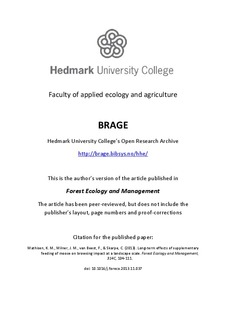| dc.contributor.author | Mathisen, Karen Marie | |
| dc.contributor.author | Milner, Jos M. | |
| dc.contributor.author | van Beest, Floris M. | |
| dc.contributor.author | Skarpe, Christina | |
| dc.date.accessioned | 2014-02-05T09:01:02Z | |
| dc.date.available | 2014-02-05T09:01:02Z | |
| dc.date.issued | 2014 | |
| dc.identifier.citation | Mathisen, K. M., Milner, J. M., van Beest, F., & Skarpe, C. (2013). Long-term effects of supplementary feeding of moose on browsing impact at a landscape scale. Forest Ecology and Management, 314C, 104-111. | no_NO |
| dc.identifier.uri | http://hdl.handle.net/11250/134660 | |
| dc.description | This is the author's version before it was send to the publisher. Therefore it can differ slightly from the published version. For the published version, please go to: http://www.sciencedirect.com/science/article/pii/S0378112713007925 | no_NO |
| dc.description.abstract | Supplementary feeding of wildlife is a common management practice, increasingly used to
reduce or divert herbivore impact from sensitive habitats, forestry or agriculture. The
landscape-scale spatial distribution of herbivory in relation to supplementary or diversionary
feeding stations is of particular relevance to wildlife and land management, yet has never been
quantified. We considered multiple hypotheses, based on central-place foraging theory, to
investigate how landscape-scale browsing impact changed as a function of distance from
feeding stations and thereby test the effectiveness of diversionary feeding. We assessed the
landscape-scale browsing impact of moose by quantifying browsing patterns and moose
density in commercially-valuable young Scots pine stands in an area of south-east Norway
with a long history of winter feeding. We also used positions from GPS-collared female
moose to investigate the spatial distribution of individuals across the landscape. Moose
density and browsing impact at a fine spatial scale (<1km) followed an exponential decrease
with distance from diversionary feeding stations. However, at a landscape scale (1-10 km),
browsing impact did not show any relationship with distance to feeding stations. Leader stem
browsing on Scots pine trees was high at both the local (< 1 km; 68 ± 12 %) and landscape (1-
10 km; 56 ± 7 %) scales. In addition, browsing on commercially valuable Norway spruce,
which is normally avoided by moose, was locally high around feeding stations. As currently
practiced, long-term diversionary feeding of moose was ineffective in diverting browsing
impact from young pine stands at the landscape scale. Browsing on commercially-important
tree species was sufficiently high that economic consequences could be expected. To avoid
further conflict, we suggest a combination of reducing the moose density and increasing the
availability of natural or more attractive supplementary forage. | no_NO |
| dc.language.iso | eng | no_NO |
| dc.publisher | Elsevier Science | no_NO |
| dc.subject | Alces alces | no_NO |
| dc.subject | browsing impact | no_NO |
| dc.subject | central-place foraging | no_NO |
| dc.subject | Pinus sylvestris | no_NO |
| dc.subject | supplemental feeding | no_NO |
| dc.subject | diversionary feeding | no_NO |
| dc.title | Long-term effects of supplementary feeding of moose on browsing impact at a landscape scale | no_NO |
| dc.type | Journal article | no_NO |
| dc.type | Peer reviewed | no_NO |
| dc.subject.nsi | VDP::Mathematics and natural science: 400::Zoology and botany: 480 | no_NO |
| dc.source.pagenumber | 104-111 | no_NO |
| dc.source.volume | 314 | no_NO |
| dc.source.journal | Forest Ecology and Management | no_NO |
| dc.identifier.doi | 10.1016/j.foreco.2013.11.037 | |
